Hong Kong leader John Lee tours border checkpoint, says return of normal travel is the next target.
Thousands of eager travellers descended on newly reopened border checkpoints early on Sunday to cross between Hong Kong and mainland China for family reunions or business purposes without the need to quarantine for the first time in three years.
At the Lok Ma Chau spur line checkpoint, which will handle 70 per cent of the 50,000 daily quota for travellers heading to the mainland, many people had taken the first train at 5.28am from Mong Kok East station before the crossing opened at 6.30am.
It is among four border control points resuming operations, with the others being at Man Kam To, the Macau Ferry Terminal in Sheung Wan and Hong Kong China Ferry Terminal in Tsim Sha Tsui. Just three control points never closed for the pandemic – those at Shenzhen Bay Port, the Hong Kong-Zhuhai-Macau Bridge and Hong Kong International Airport.
To cross the border, Hong Kong travellers must register in advance on an online platform while mainland residents heading to the city will have to make a booking on an official Shenzhen government website.
Hong Kong security chief Chris Tang Ping-keung on Sunday morning said 7,000 people had left the city so far with half of the daily quota taken.
More than 6,600 mainland residents have booked to visit Hong Kong, including 3,800 via the Futian checkpoint, with peak hours expected from around 8am to 10am and at 2pm.
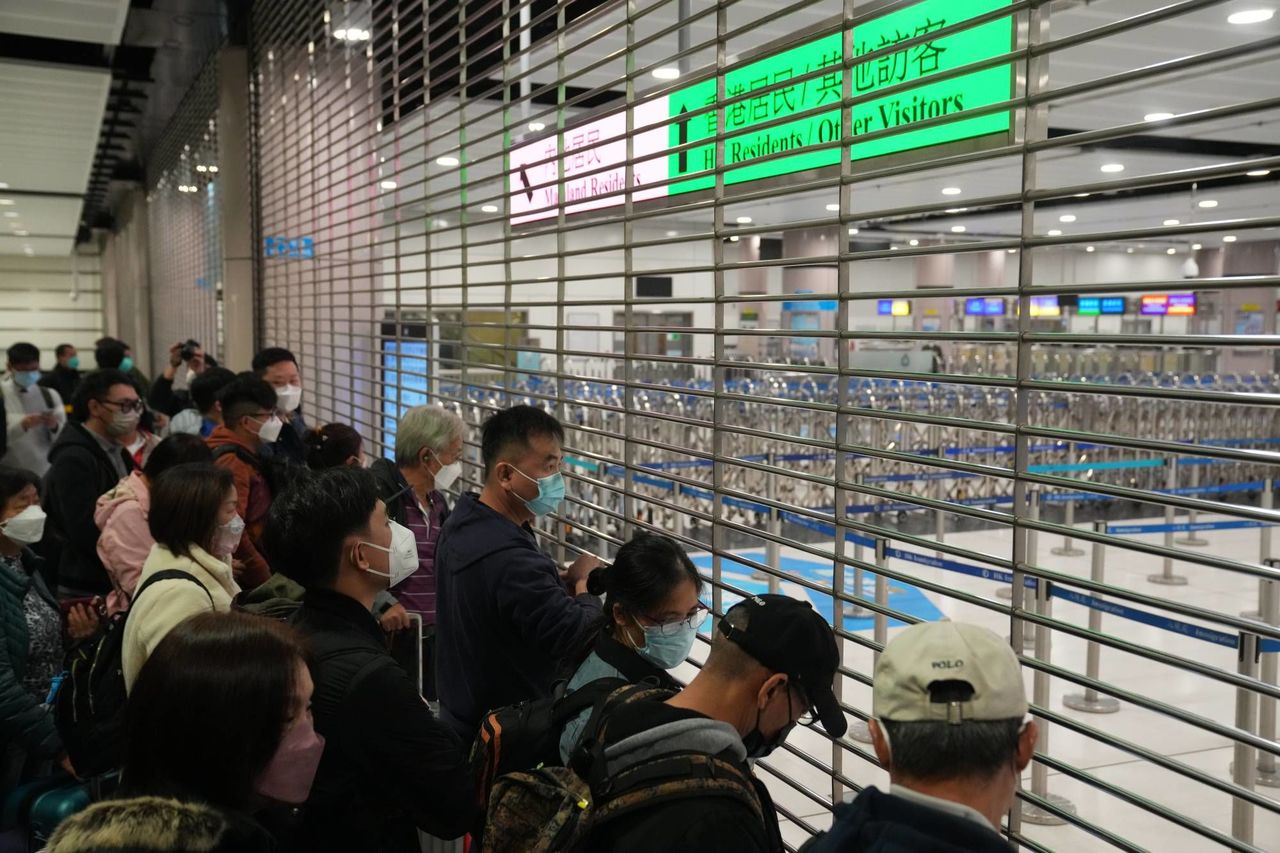 Early-morning passengers wait patiently to cross the border.
Early-morning passengers wait patiently to cross the border.
Demand for crossing the border was heavy. More than 440,000 Hong Kong people had registered on the online platform as of 6pm on Sunday, with dates around Lunar New Year on January 22 almost fully booked.
Sunday also marks the day that the mainland resumes quarantine-free travel for the first time in three years and ditches most pandemic restrictions.
Here are updates on the long-awaited return of quarantine-free movement between Hong Kong and the mainland:
Most travellers heading north
Provisional statistics from the Immigration Department showed 36,669 passenger trips were recorded at five Hong Kong-mainland control points, with 28,875 or nearly 80 per cent of them northbound, as of 4pm. The Lok Ma Chau railway station recorded the largest number of passenger trips, at 18,314 as of 4pm.
The airport handled 32,050 passenger trips, covering international destinations as well as the mainland. A total of 2,059 passenger trips were recorded at the Macau Ferry Terminal.
Where are the shoppers?
A Post reporter toured several dispensaries in the Sheung Shui border district, which used to be popular with mainland shoppers and parallel traders, and found few customers.
“I haven’t seen many customers speaking in Mandarin yet, only three or four so far,” said an employee of Hong Hing Dispensary at around 1pm. “Today is still the first day and I suspect more people will come over later.”
Supplies of fever and diarrhoea medicines – used for treating Covid-19 symptoms – had run out and had not been replenished, he added.
At New Town Plaza in Sha Tin, a shopping centre once crowded with cross-border visitors taking the East Rail line, another Post reporter found only two shoppers from Shenzhen out of 20 people interviewed.
Electronics technician Xia Jie, 26, arrived in Hong Kong around noon with his girlfriend and had planned to spend 30,000 yuan on gadgets, but in vain.
“Both the iPhone 14 Pro Max and [Sony] PS5 [game console] are out of stock. The staff from Apple Store said it will be available for delivery on January 12 at the earliest, but we are only staying for three days,” said Xia, who last visited Hong Kong in 2019.
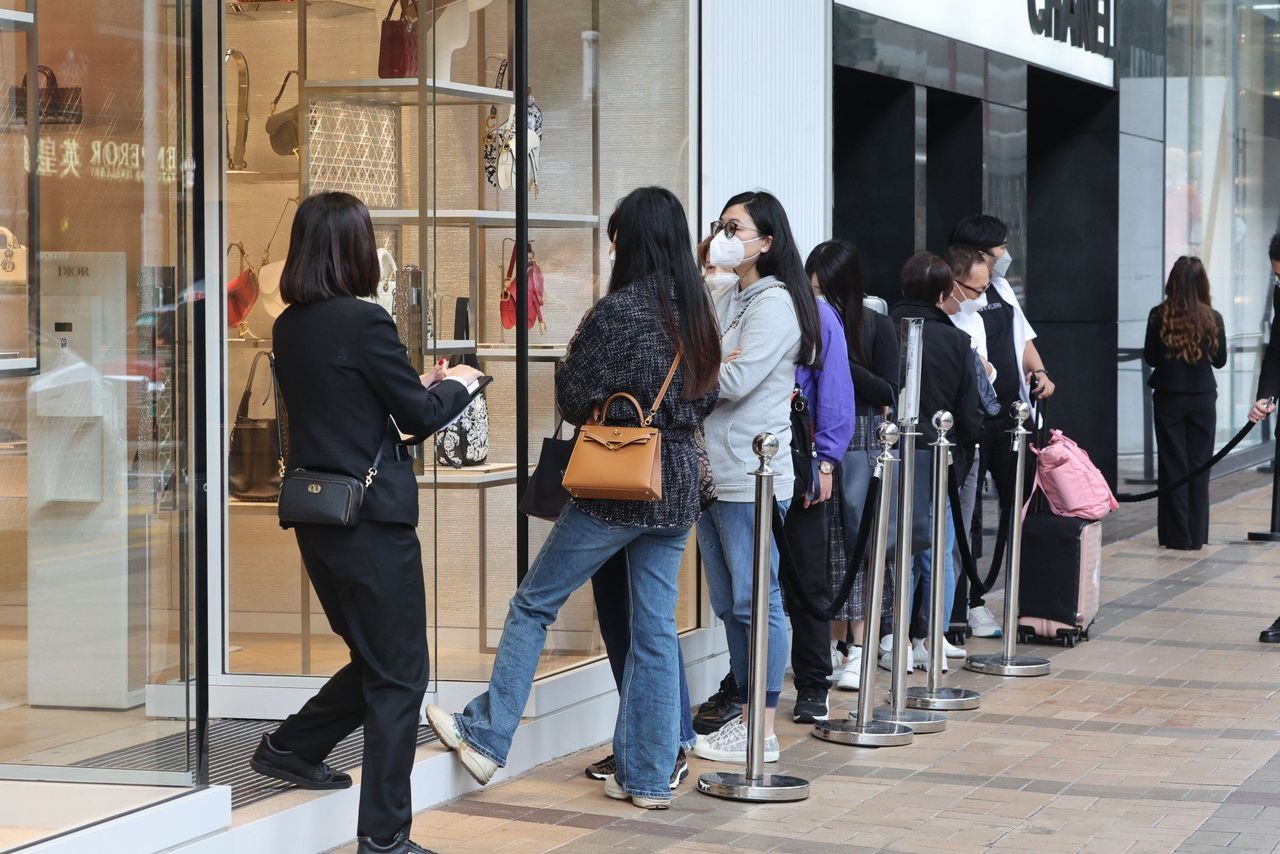 Shoppers wait to get into a store in Tsim Sha Tsui.
Shoppers wait to get into a store in Tsim Sha Tsui.
The pair then headed off to Tsim Sha Tsui to hunt for deals on sportswear and clothes.
Feng Qin, 52, a stay-at-home mother from Futian who had travelled to Hong Kong for the first time since 2019, was shopping for a gift for her 23-year-old daughter’s wedding in April.
She ended up spending HK$40,000 on a pair of gold wedding bracelets and a gold pig necklace at a jewellery store in New Town Plaza.
“The craftsmanship is definitely more delicate with more choices in Hong Kong. I want my only daughter to look decent at the wedding,” Feng said.
“I will stay with my cousin for five days and we’ll go shopping together for some dry seafood for Lunar New Year. Products in Hong Kong have a better reputation.”
Goodbye ‘Leave Home Safe’ app
The Office of the Government Chief Information Officer has announced that the “Leave Home Safe” risk-exposure app had ceased operations and would not be updated after the resumption of cross-border travel.
The office said it had deleted all visit records of users who earlier uploaded to the app, especially those of people who were infected, as instructed by the Department of Health. But users can keep the app if they wish to use other functions such as PCR testing registration.
‘Daily Covid caseloads will rise with reopening’
Government pandemic adviser Professor David Hui Shu-cheong of Chinese University warned that infections in Hong Kong would rise following the resumption of quarantine-free travel.
However, with more than 60 per cent of Hong Kong’s population previously infected and a high vaccination rate overall, he said the city had a strong immunity barrier and anticipated that even if people caught Covid-19, it was hoped their symptoms would remain mild.
“If the proportion of severe and death cases increases and our healthcare system is overburdened, the authorities could consider reducing the quota for crossing the border, requiring mainland travellers to be vaccinated and do more PCR tests,” he said.
Hong Kong reported 14,113 new coronavirus infections on Sunday, 431 of which were imported, as well as 66 more deaths. The city’s Covid-19 tally stood at 2,769,940 cases and 12,342 fatalities.
‘First good news of 2023’: finance chief
Financial Secretary Paul Chan Mo-po said in his weekly blog post that the border reopening was “the first good news of 2023” for residents waiting for family reunions and businesspeople ready to return to the mainland.
“As border crossing gradually becomes more convenient, it is expected that the flow of people and logistics will improve significantly, which will bring greater support to Hong Kong’s export, tourism, retail and catering industries,” Chan said.
New attractions on itinerary for visitors
Shenzhen resident Sandy Chen, an executive with an electronic manufacturing firm who also holds a Hong Kong ID card, set off to visit the company’s office in Kwun Tong and the Palace Museum in West Kowloon.
The 47-year-old said she had been forced to work from her Shenzhen home instead of crossing the border each day for her job.
“In these three years Hong Kong has changed a lot and there is now the Palace Museum,” she said. “I will meet up with my colleagues and we’ll visit the museum together.”
Gao Ri, a 45-year-old trader, flew from Beijing to Shenzhen with his son and wife to cross the border at Futian, a route he found “more convenient” to get to Hong Kong.
High on the priority for the Beijing residents was to replace their Hong Kong ID cards. They also budgeted 100,000 yuan (US$14,620) for a weeklong holiday.
“We’d like to go sightseeing at some villages and hiking, getting a sense of the rural Lingnan culture. I think this should be more meaningful than going to shopping malls,” Gao said.
 The Lok Ma Chau station border crossing was packed on Sunday morning.
The Lok Ma Chau station border crossing was packed on Sunday morning.
Rail firm deploys 300 staff for crowd control
Rail operator the MTR Corporation’s chief of the cross-boundary segment, Cheung Chi-keung, said 300 staff were deployed to control crowds as 9,000 passengers had taken trains to and from the Lok Ma Chau spur line checkpoint as of 11am. As of 5pm, a total of 16,500 passengers had taken trains. Lok Ma Chau-bound trains were running every four to eight minutes. Most shops at the checkpoint have reopened.
He said the resumption of services at the West Kowloon terminus of the Guangzhou-Hong Kong-Shenzhen Express Rail line was expected before January 15, with details of ticketing arrangements to be made available soon.
Transport minister Lam Sai-hung, who toured the local checkpoint of the Hong Kong-Zhuhai-Macau Bridge, said drills for high-speed rail services were under way.
He added that transport operations were running smoothly and that authorities were liaising with providers to ensure services were sufficient.
Visitors set for family reunions, hiccups for others
Yang Yang, a finance executive in his 30s working in Shenzhen, said he would travel to Hong Kong more often to be with his wife and daughter after only being able to spend 20 days with them in the past three years.
“Now I want to make up for the time I have lost,” Yang said after passing through the Lok Ma Chau railway station control point. He said he wanted to return to Hong Kong every week soon and in time restore his previous practice of heading back every day.
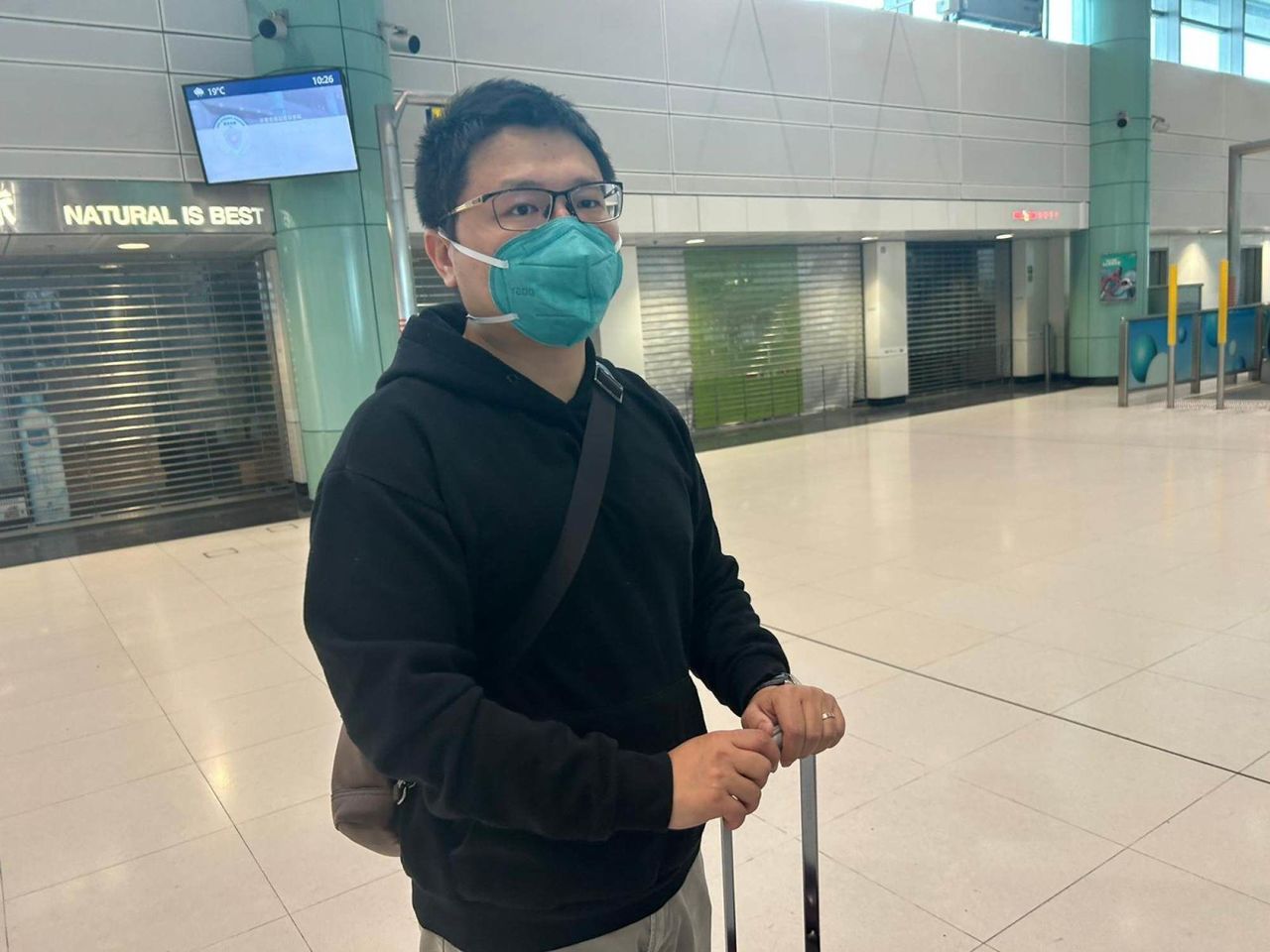 Yang Yang has only been able to see his wife and daughter for 20 days over the past three years.
Yang Yang has only been able to see his wife and daughter for 20 days over the past three years.
At Futian checkpoint in Shenzhen, Hong Kong resident and homemaker Jenny Ye, 43, chose Sunday to return to the city to avoid any quarantine problems after visiting her ill father in Heyuan, Guangdong, on December 24.
But she wrongly assumed she did not need to obtain a negative PCR test result because Hong Kong residents were not required to book a place in advance on an official Shenzhen website. Frustrated, she searched for a test centre.
“Hong Kong made it very clear that you need to do a PCR test [before travelling to the mainland], but on this side it isn’t that clear that the testing rule applies to everyone,” she said.
Half of Sunday’s daily quota used up: security chief
Security Bureau chief Chris Tang said half of Sunday’s cross-border quota had been taken, with 7,000 people leaving Hong Kong so far on Sunday morning. A total of 5,000 went through the Lok Ma Chau railway station crossing and the rest mainly through Shenzhen Bay.
“Travellers should prepare with relevant documents because more people are going to cross the border in the next few hours,” Tang said at about 10.45am after he inspected the Shenzhen Bay control point.
Hong Kong back in business for mainland residents
Mainland travellers are visiting Hong Kong for various reasons.
Jacky Hu, an entrepreneur in his 30s, arrived in the city for the first time since 2019 to attend a trade show on Tuesday.
“My business has suffered because I was unable to come to Hong Kong to meet partners or potential customers at any trade exhibitions for three years,” he said after passing through the Lok Ma Chau checkpoint.
Hu is set to participate at the four-day Hong Kong Baby Products Fair at the Convention and Exhibition Centre in Wan Chai.
Sammy Zhang, an entrepreneur in her 40s who plans to attend the same show, said crossing the border was very convenient and only took her an hour.
“Compared with two months ago when I last visited Hong Kong, it is way more convenient now. Since the shopping paradise is back, I plan to travel to Hong Kong more often,” she said.
At the Hong Kong China Ferry Terminal, 40-year-old exporter Liu Ge arrived in the city with her brother and 10-year-old son from Shenzhen airport. They said their trip was multipurpose, including attending the trade fair and renewing travel documents.
“We were the only people on the ferry, and immigration staff were friendly. Everything is going so well,” she said. “We missed local Hong Kong food such as beef balls and plan to go to the Wong Tai Sin temple to worship the gods for good luck.”
Hong Kong leader pledges to restore normal travel
Chief Executive John Lee and his No 2, Chief Secretary Eric Chan Kwok-ki, toured immigration counters at the departure hall of the Lok Ma Chau station border control point from 8.30am. Immigration officers briefed the two about border clearance.
Lee said security chief Chris Tang Ping-keung and Secretary for Transport and Logistics Lam Sai-hung would visit other checkpoints to ensure expectations were met on the first day of travel, which were for operations in a safe and orderly manner.
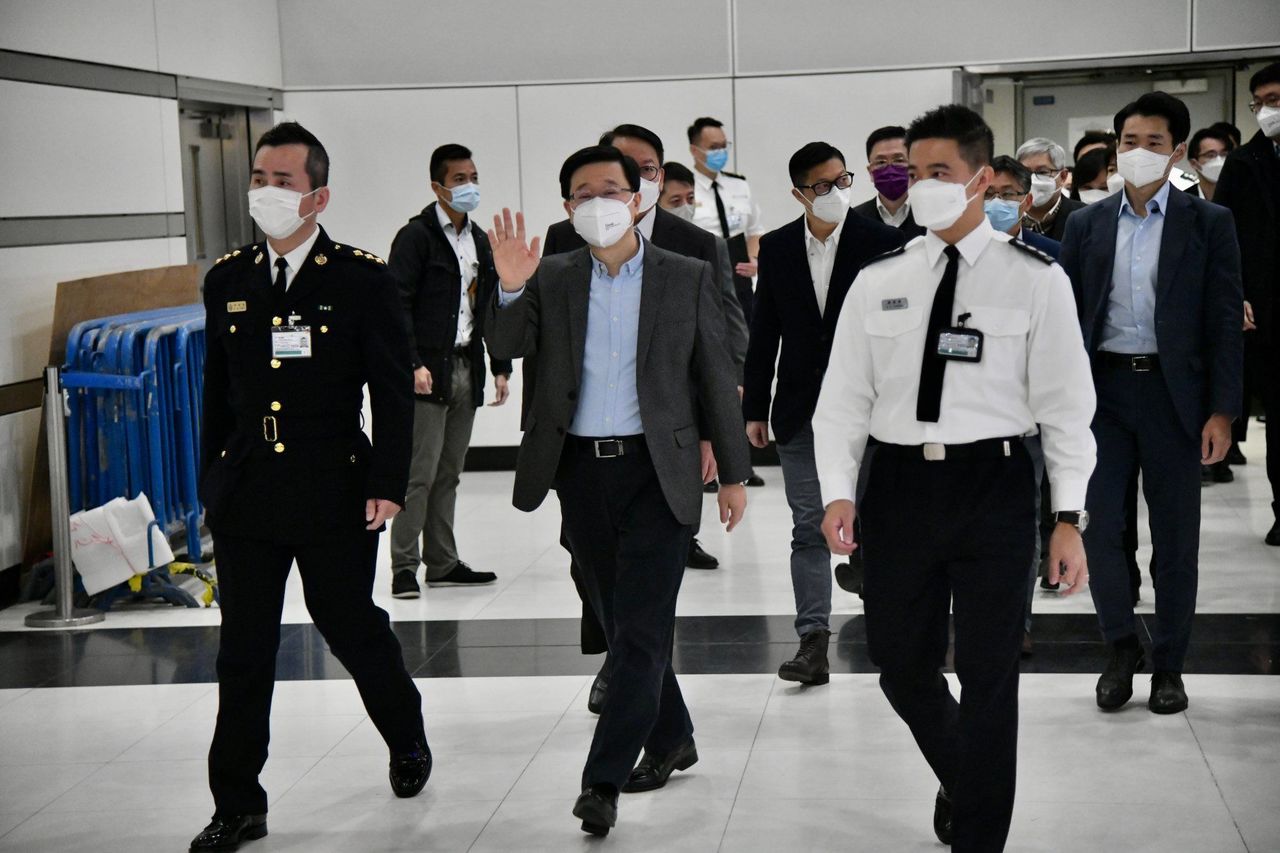 Chief Executive John Lee (centre) inspects operations at the Lok Ma Chau spur line control point.
Chief Executive John Lee (centre) inspects operations at the Lok Ma Chau spur line control point.
He pledged to restore normal travel by totally lifting the daily quota on traveller numbers, but did not specify a date.
“We will discuss with mainland authorities our next step after considering the reopening situation before and during the Lunar New Year holiday,” he said. The Lunar New Year starts on January 22.
He said he also wanted to visit the Greater Bay Area soon to promote cross-border cooperation.
Lee revealed about 1,000 places were still available on the online booking system for January 20, which had the highest demand. The most-sought after date was followed by January 19 and January 21.
He highlighted that the government’s medical experts had said infection risks after the resumption of quarantine-free travel were manageable.
Chief Secretary Chan addressed worries about a comeback of rampant parallel trading that plagued land checkpoints before the pandemic.
“We don’t expect the problem of parallel goods traders will be serious because there are not a lot of people coming to Hong Kong at this stage,” he said.
Lee said Deputy Chief Secretary Cheuk Wing-hing had held a meeting over handling potential parallel trading and the authorities had put in place arrangements to avoid a return of the problem.
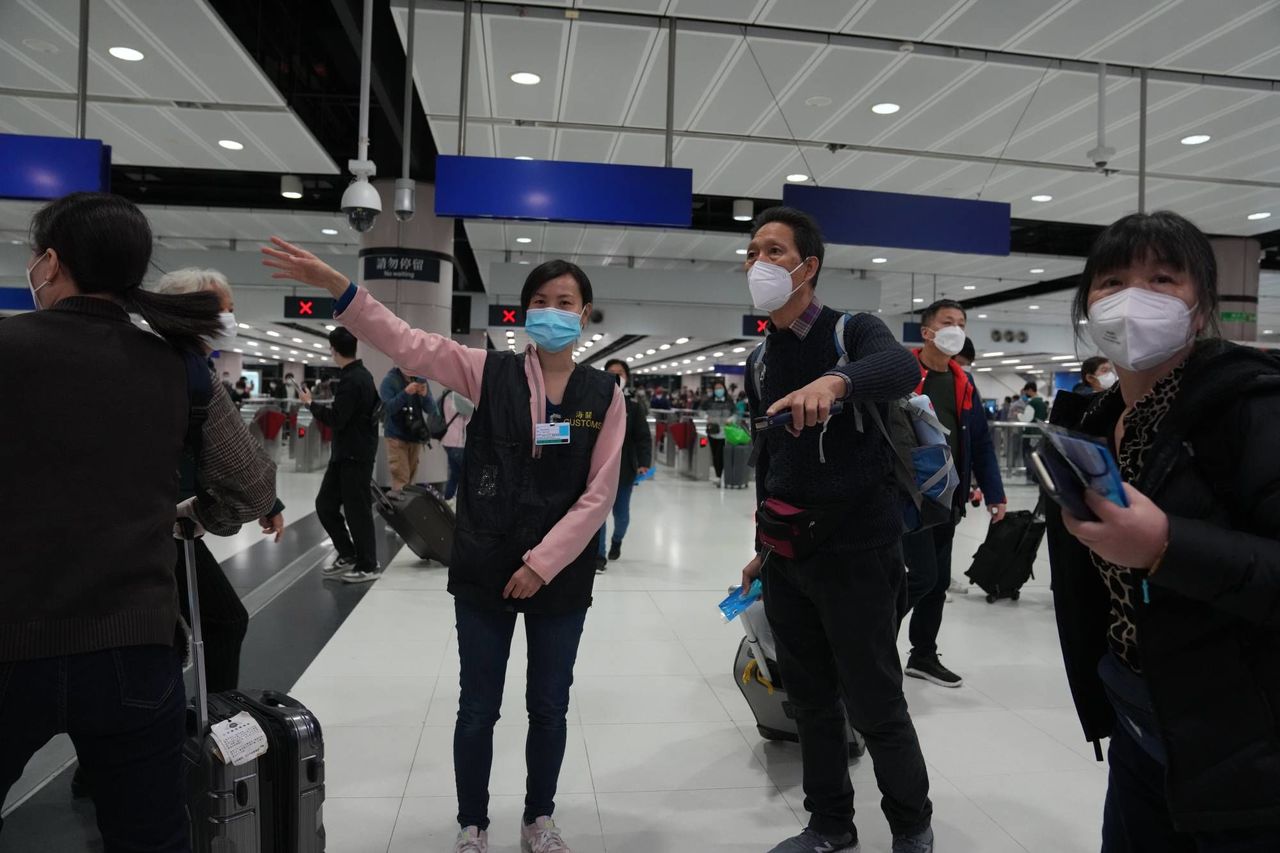 Customs officers are on hand to help travellers.
Customs officers are on hand to help travellers.
Crowds at other checkpoints
Queues were seen in the departure hall at Shenzhen Bay, but overall in an orderly manner.
At the Hong Kong China Ferry Terminal, only three turbo-jet vessels operated by Chu Kong Shipping were heading to Shenzhen airport and two to Shekou on Sunday. About 70 passengers took the first ferry to the airport at 8.20am. The company said it aimed to restore services to other destinations such as Nansha.
“This has historical meaning to us – we witnessed the first ferry in this terminal for three years,” an employee surnamed Ho said.
Guo Zhiqing, a 43-year-old worker with a shipping firm in Hong Kong, was overjoyed to return home to Guangdong for the Lunar New Year holiday.
“I am too excited to say a word, I finally can go home after two years of separation with folks. Look at my eyes, I lost sleep last night,” he said.
Ferries to Taipa in Macau also resumed on Sunday, with Shun Tak Holdings’ TurboJet operating five sailings between 10.30am and 3.30pm from Hong Kong and seven trips between 10am and 6pm in the other direction.
Another operator, Cotai Water Jet, is running two sailings to Taipa at noon and 4pm and three trips to Hong Kong between noon and 6.30pm.
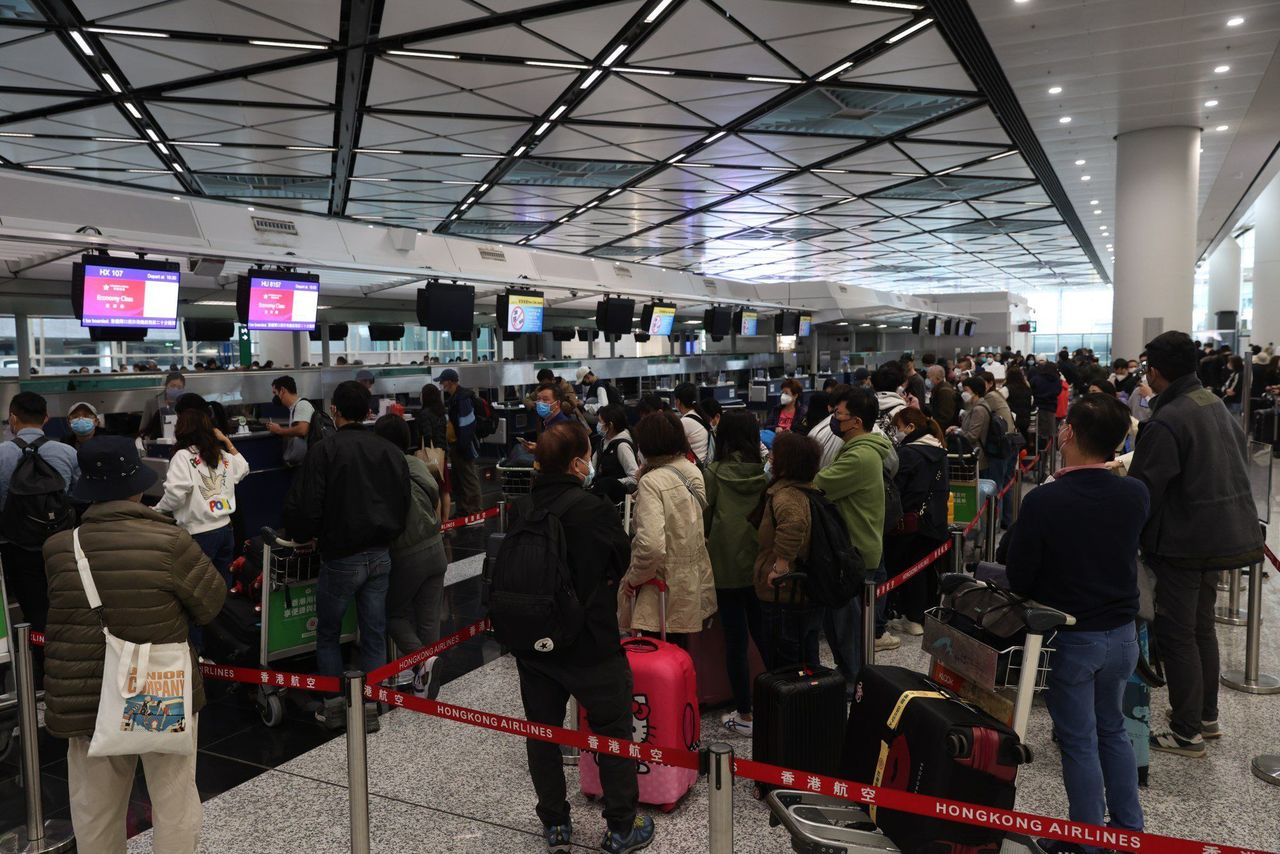 Passengers queue up to check in for flights to the mainland at Hong Kong International Airport.
Passengers queue up to check in for flights to the mainland at Hong Kong International Airport.
Emotional reunion
Zhou Yuhang, 24, was among the early birds arriving at the Lok Ma Chau checkpoint and could not wait to see his girlfriend for the first time in six months.
The semiconductor firm engineer, who carried a handbag he had bought as a gift, took the first train after Wong Tai Sin station opened at 5.50am.
As Zhou crossed the bridge heading towards the mainland, the vista of the Shenzhen River reminded him of how he and his girlfriend waved to each across the water back in November. “We no longer need to see each other 100 metres apart,” he said.
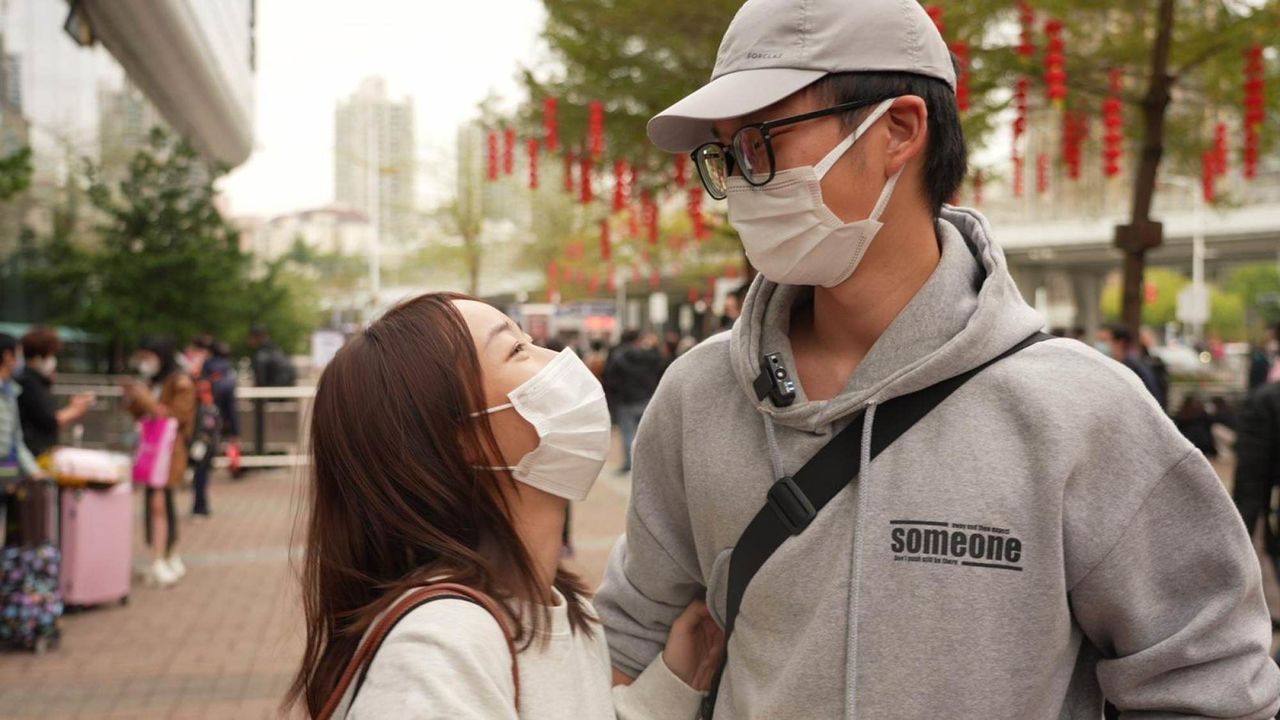 The first stop for Zhou Yuhang and girlfriend Karin Xu is breakfast somewhere.
The first stop for Zhou Yuhang and girlfriend Karin Xu is breakfast somewhere.
The couple embraced and spun around when they met.
“I feel so emotional and strange at the same time … We really haven’t met for too long,” said his girlfriend, 24-year-old car company saleswoman Karin Xu.
Breakfast together was the first thing on their agenda. “We need to find a place to eat something, I’m so hungry now,” she said.
Smooth clearance at border crossing
A Post reporter took about 50 minutes to travel to the Lok Ma Chau railway station checkpoint, arriving at about 7.20am and joining at least 500 travellers waiting at counters for customs clearance. The crowds packed most of the departure hall.
At electronic clearance counters, there were more customs officers helping check travellers’ PCR test results.
Overall, the clearance was smooth. It took 10 minutes to cross the Hong Kong border.
Across the bridge that leads to the Shenzhen checkpoint, there were more people and clearance took longer, at about 15 minutes.
Queues were considerably longer on the Shenzhen side for Hongkongers who had not signed up for the automated border clearance with their travel documents.
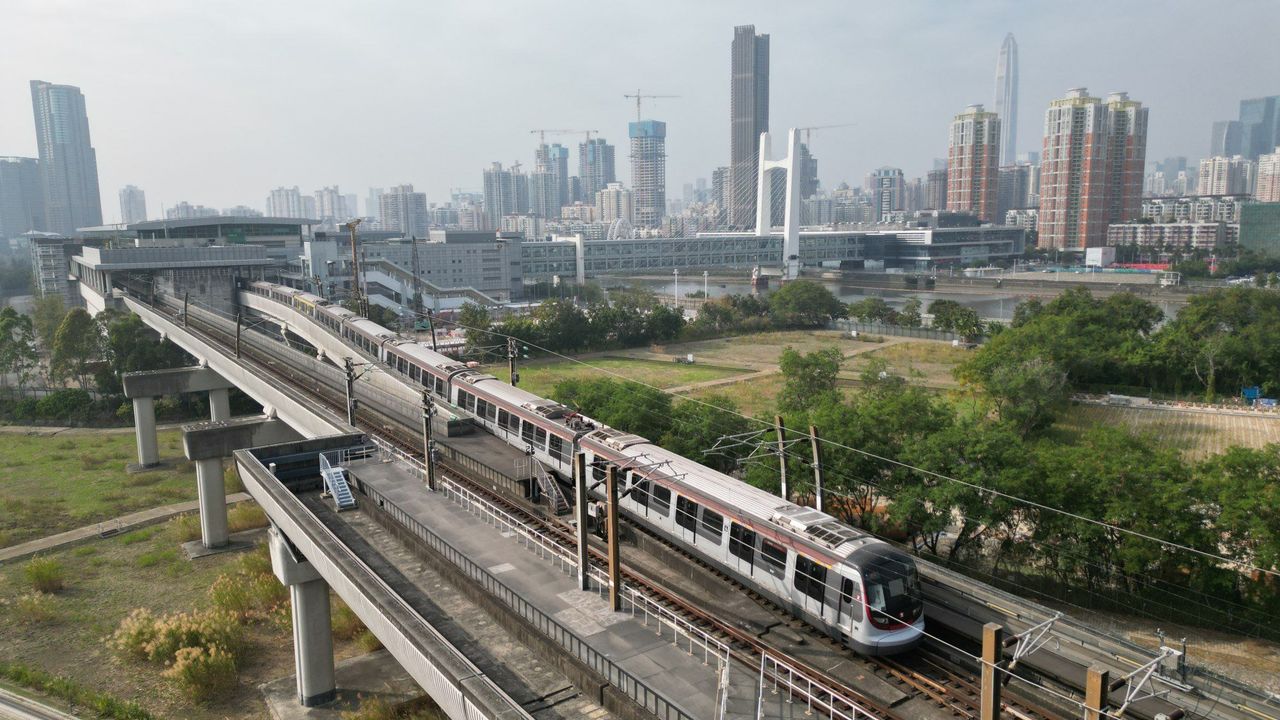 The Lok Ma Chau station at the border.
The Lok Ma Chau station at the border.
Travellers fill up early trains
Suitcases lined carriages in one of the earliest East Rail line trains heading for Lok Ma Chau station from Admiralty on Hong Kong Island at 6.30am. The journey takes 50 minutes to the Lok Ma Chau station and then another 11 minutes to walk to the checkpoint after disembarking from a train.
Among the passengers was homemaker Alice Chen, 50, who boarded at Admiralty at 6.30am with her husband. She has not returned to her hometown of Chongqing for nearly three years.
“I’m so excited I couldn’t sleep and woke up at 2am,” she said.
She was carrying some stomach medicines for her family, but refrained from carrying painkillers because she feared she would be caught by customs officers.
Painkillers are ruled to be controlled drugs and require a permit for exports, but the government has said passengers are allowed to travel with a few boxes for personal use.















